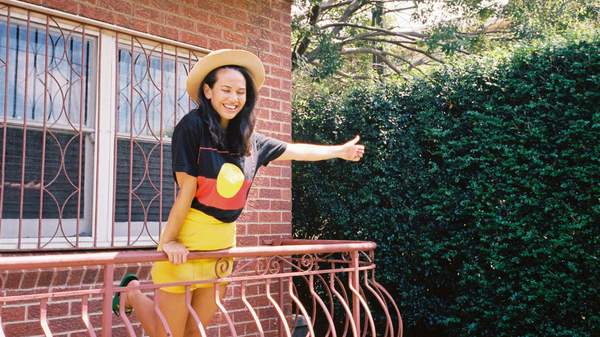Overview
Amrita Hepi wants you to dance away shame. She told you, us and thousands of keen ears at this year's TEDxYouth last week. A lifelong dancer, a writer, an activist and a Bundjulung/Ngapuhi woman, Hepi is a busy one. From running the Hollaback dance class in Surry Hills and highly popular Beyonce and Rihanna dance classes at Plan B Small Club to hosting Dance Dance Revolution on FBi Radio and curating a performance for Melbourne's Next Wave Festival, TEDx is the next achievement she can add to her impressive resume.
We were lucky enough to nab an exclusive interview with Hepi the day before TEDx, 24 hours before she delivered a speech on 'dancing your way through shame' to a Sydney audience and streaming listeners Australia-wide. Think nuggets of wisdom like this on stage:
"Even the best dancers and heaviest drinkers have that worry... [of] not wanting to make a total fool of [themselves]... The next time you get an offer to join in, commit to your movements. There's nothing to lose in your movement, you can be as loud and as big as you want... The next level, the Jedi level, is to commit to your action and be able to be generous enough to help others dance with you."
Let's get moving.
How does it feel to have been asked to speak at TEDxYouth this year? What's your TED Talk about?
I feel really privileged and grateful. When they first asked me, there was a list of 50 people to interview, so I was not expecting much!
I may call the speech 'How to Dance Better at Parties' — it's about commitment to action and the idea that, if you're a really good social dancer, you're committed to your movement, and if you're exceptional then you can involve others in it too, without shame.
Can you tell us more about this concept of 'shame'?
It comes with being a woman, and also as a woman of colour. There are these ideas of embarrassment around certain parts of the body and the way people are looking at you. There's especially a long history of shame in the Indigenous community. When I started teaching, I wanted to find a way to navigate that shame — to get rid of it for myself and help others to do the same. The only way to do it is to have the discussion.
But shame doesn't only apply to women either. It's more the way people, men and women, assign themselves to gender fields. It's the idea of engendered roles and how we're taught to operate in society. How did we get to that? You don't really have to operate on that level or do that role, and that's part of what I try to teach through my classes.
Can you tell us a bit more about your own background as a dancer?
I started dancing when I was three and I loved it. I went to dance school from about age nine until I was 18 or 19 when dance, for me, became so shame fueled and uncomfortable. I was worried about being looked at in the right way, at the right time. Women have to disappear or only appear in the right ways. So I stopped dancing for a year. I started teaching classes again to dance through this shame.
What sets TEDxYouth apart from TEDx?
There's such a difference between the two rooms – people in the main hall are all very professional in their fields and the speeches are looked at as a tool. People watching TEDxYouth are looking up and getting inspired. It's that mentality of "I could do that one day."
Movement and body for youth are specifically important and can be really instrumental in spacing language. Language is so important because the language we use goes straight into the mouths of others. I remember watching public speaking and debating when I was in primary and high school and the lasting effect it can have. If one person finds my speech helpful and it changes one person's idea of shame, well the butterfly effect of that is very powerful. It's a small conquest.
Amrita wasn't the only one dropping truth bombs at TEDxSydney and TEDxYouth this year. Returning to the Opera House with an all-star lineup of speakers and performers, TEDx saw an overriding theme focused on the importance of communication and the connections you can make through different forms of conversation. For those really looking to connect, TEDx replaced Tinder for the day, supplying event goers with red and rainbow heart shaped stickers to help the singles to mingle.
Dr. Jordan Nguyen spoke about the ability to communicate with ourselves and with others more effectively through virtual reality, giving users the ability to literally step into someone else's shoes. Neurogamer Karen Palmer discussed how mind-focusing virtual games can help take control of your life and find courage in your goals and ambitions.
Peta Murchinson expressed the power of human connection and kindness, while finance researcher Elise Payzan-Lenestour discussed the recklessness inherent in human nature. Cartoonist Cathy Wilcox spoofed on the same theme in her satirical speech on the "culture of outrage."
Masculinity expert Dr. Michael Kimmel urged men to "talk our walk" and to re-communicate the meaning of masculinity to boys. Radical body activist Kelli Jean Drinkwater discussed self-worth, shame, and reclaiming your body and space.
Natalie Jeremijenko, donning a tiara, spoke about a physical version of reclaimed space, discussing her projects to create a healthy urban ecosystem and reconnect to the world around us. These include tree offices, butterfly bridges, and an inner city zip line transportation system. Emily Parsons also touched on our environment and gave one of the most powerful speeches of the conference in her discussion on the breathable air of our past and future and its unspoken influence for life on earth.
You can watch TEDxSydney and TEDxYouth talks here.
